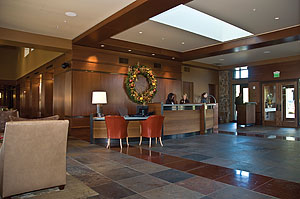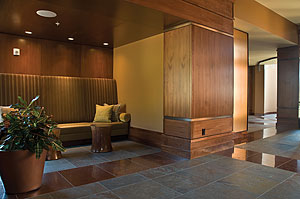Bridging Luxury and Nature with Stone
www.stonexp.com
2010-11-06 10:24:08
Popularity Index:0
Source:Internet
When it came time for the material selection, “it is safe to say that stone was a given from the beginning,” said Bradley. “The Austin family clued in quickly to the inherent qualities of stone — longevity, durability and strength.
“The interesting part was the exploration for the entire design team that got us to the final design,” Bradley went on to say. “There were no preconceived notions. We had to create a design process. We went through a variety of patterns and design types and mock-ups to narrow down [the choices]. We thought of stone from the get-go, but we didn’t know exactly what type it would be. There was a lot of exploration used to search for the stone. We were looking at what quarries were available and the overall appearance [of the material].” After a thorough search, the decision was made to use sandstone quarried in Montana for the resort’s exterior facade. “In the end, the contractor located a stone from Montana called Montana Mossy Rock,” said Schaefer. “It has a lot of lichen and rich coloration to it.” The material, which was culled from several quarries in Montana, was supplied by Stone NW of Vancouver, WA.
Schaefer went on to explain that there is an interesting connection with the stone that relates back to the site. “The Allison name comes from a prehistoric lake that was in the area,” she said. “A geologist named Ira Allison, a professor at Oregon State University, helped prove the existence of the lake that was formed by a massive glacial flood about 15,000 years ago. In that process, the glacial flood originated in what is now Montana and deposited in Oregon, creating the pre-historic lake and the subsequent fertile Willamette Valley. The lake doesn’t exist any more, but the soil left in the Willamette Valley by the glacier has the same chemistry as a lot of Montana topsoil.” The design team wanted a randomness to the exterior stonework, as if the stone was found and stacked up, according to Bradley. “We used garden walls as imagery,” he said. “The pieces were as small as 6 x 6 inches and up to 24 x 24 inches in size. Probably the most important dimension was 6 x 6 inches. We wanted the mason to understand that we didn’t want any small infill pieces. To their credit, they did a great job.” In addition to the Montana sandstone, Bluestone — supplied by Guinett Masonry, Inc. of Vancouver, WA — was employed as paving for walkways and patios. The material was complemented by a border of Chinese Redheart limestone, which was supplied by Yellow Mountain Stoneworks Inc. of Seattle, WA. Approximately 4,000 square feet of Chinese Redheart limestone was utilized as an accent paving band for the exterior arrival court, according to John Williams, President of Yellow Mountain Stoneworks. In addition to the arrival court, Redheart limestone is featured as an accent band with Bluestone pavers on the pool terrace. “As is typically the case, a lot of times we find that an architect chooses one of our materials, and it ends up being used in a lot of different applications,” said Williams. |





